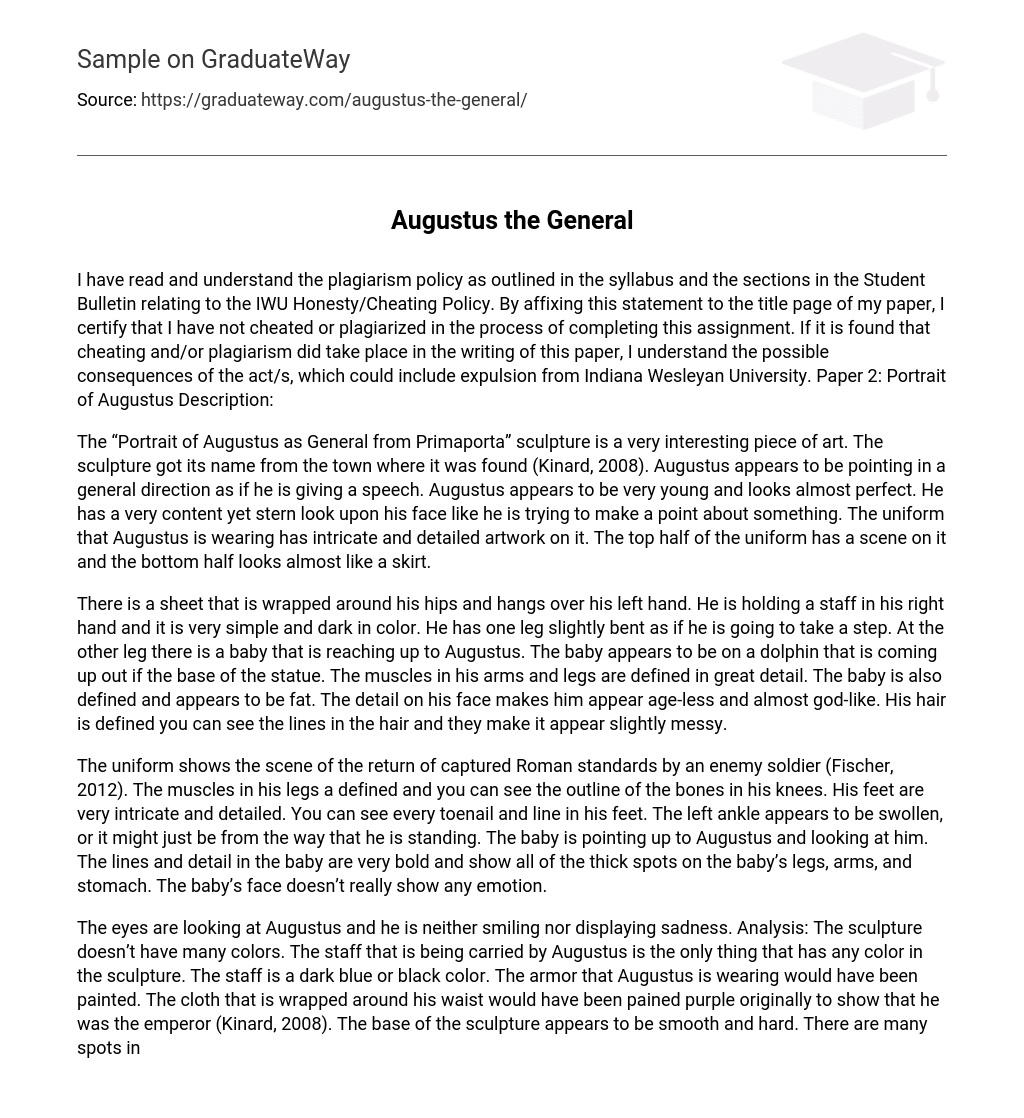I understand and accept the plagiarism policy outlined in the syllabus and the sections regarding the IWU Honesty/Cheating Policy in the Student Bulletin. I affirm that I have not cheated or plagiarized in completing this assignment. If it is found that cheating or plagiarism has occurred during the writing of this paper, I am aware of the possible consequences, which may include expulsion from Indiana Wesleyan University. Paper 2: Portrait of Augustus Description:
The sculpture known as “Portrait of Augustus as General from Primaporta” is a fascinating work of art. Its name derives from the location where it was discovered (Kinard, 2008). In the sculpture, Augustus can be seen gesturing in a general direction, as though delivering a speech. The depiction of Augustus portrays him as youthful and nearly flawless. His countenance is both content and firm, suggesting that he is intent on making a significant statement. The uniform worn by Augustus is adorned with intricate and elaborate artwork. The upper portion of the uniform features a scene, while the lower portion resembles a skirt.
Augustus is depicted in this statue wearing a sheet around his hips, hanging over his left hand. He holds a simple and dark-colored staff in his right hand, while one of his legs is slightly bent as if he is about to take a step. An interesting element is the presence of a baby on his other leg, reaching up towards him. This baby seems to be riding on a dolphin emerging from the base of the statue. The sculptor has paid great attention to detailing the muscles in Augustus’ arms and legs. Similarly, the baby is also well-defined and appears chubby. The sculpture’s face is intricately crafted, giving it a timeless and almost divine appearance. The hair is particularly notable, with visible strands that create a slightly disheveled effect.
The soldier, portrayed in the uniform, showcases the moment of the enemy soldier returning the captured Roman standards (Fischer, 2012). The definition of his leg muscles and the outline of his knee bones are visible. The intricate and detailed depiction of his feet reveals every toenail and line. The left ankle appears swollen or due to the soldier’s stance. Meanwhile, a baby points upwards towards Augustus, gazing at him. The bold lines and detailed features depict thick areas on the baby’s legs, arms, and stomach. However, the baby’s face lacks any visible emotion.
Augustus is the focus of the observer’s gaze, his expression devoid of both happiness and sorrow. The sculpture primarily lacks vibrant hues, with the staff being the only element exhibiting any color, specifically a deep blue or black shade. Paint would have been applied to the armor worn by Augustus, while the cloth adorning his waist originally bore a purple hue, symbolizing his position as emperor (Kinard, 2008). The sculpture’s base possesses a sleek and solid appearance. Various areas of the sculpture, including the face, arms, legs, and baby, exhibit smooth textures.
The texture of the cloth and uniform gives a rough sensation due to the numerous lines that define its appearance. The sculpture’s emotion is one of tranquility, as Augustus seems to convey a calm demeanor while addressing his people. Moreover, this artwork conveys a sense of authority, evident through elements that highlight his power and god-like qualities (Kleiner, 2010). My interpretation is that the artist aimed to depict Augustus as an incredibly influential figure. By portraying him as youthful and god-like, it signifies the profound respect and view of him as an ageless or immortal deity from the perspective of the people.
The breast plate of the uniform bears a scene that demonstrates Augustus taking credit for what he believed to be a diplomatic group, highlighting his esteemed reputation as a skilled diplomat. Symbolizing his authority and power, the staff he holds represents his commanding presence. Additionally, the presence of a baby riding on a dolphin can be interpreted as depicting Augustus as a god. This baby icon represents Cupid, while the dolphin, as a creature of the sea, symbolizes Neptune. These artistic elements were incorporated into the sculpture due to the Julian family’s claim of having divine ancestry.
In my interpretation, the artist’s message is that Augustus possessed great power and was regarded as a deity. He demonstrates his authority and does not abuse it. In my judgment, the sculpture “Portrait of Augustus as general” effectively portrays Augustus as an ageless, god-like immortal with immense power. The way Augustus stands, engaging with a crowd or group, clearly indicates that he commands respect and captivates people’s attention when he speaks. The inclusion of the staff in his hand further signifies his grandeur and authoritative status.
The emperor is indicated by the cloth around his waist, making this artwork highly successful as it portrays a lifelike Augustus, timeless and commanding, addressing a group and captivating their focus.
Reference:
Fischer, J. (2012, June). Augustus of primaporta. Retrieved from http://smarthistory. khanacademy. org/roman-sculpture. html Kinard, J. (2008, October 08). Augustus. Retrieved from http://www. historians. org/tl/LessonPlans/nc/kinard/augusintro. htm Kleiner, F. (2010). Gardner’s art through the ages: A concise western history (2nd ed. ). Boston, MA: Wadsworth





